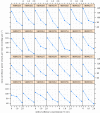Sperm velocity in a promiscuous bird across experimental media of different viscosities
- PMID: 32673555
- PMCID: PMC7423661
- DOI: 10.1098/rspb.2020.1031
Sperm velocity in a promiscuous bird across experimental media of different viscosities
Abstract
In species with internal fertilization, the female genital tract appears challenging to sperm, possibly resulting from selection on for example ovarian fluid to control sperm behaviour and, ultimately, fertilization. Few studies, however, have examined the effects of swimming media viscosities on sperm performance. We quantified effects of media viscosities on sperm velocity in promiscuous willow warblers Phylloscopus trochilus. We used both a reaction norm and a character-state approach to model phenotypic plasticity of sperm behaviour across three experimental media of different viscosities. Compared with a standard medium (Dulbecco's Modified Eagle Medium, DMEM), media enriched with 1% or 2% w/v methyl cellulose decreased sperm velocity by up to about 50%. Spermatozoa from experimental ejaculates of different males responded similarly to different viscosities, and a lack of covariance between elevations and slopes of individual velocity-by-viscosity reaction norms indicated that spermatozoa from high- and low-velocity ejaculates were slowed down by a similar degree when confronted with high-viscosity environments. Positive cross-environment (1% versus 2% cellulose) covariances of sperm velocity under the character-state approach suggested that sperm performance represents a transitive trait, with rank order of individual ejaculates maintained when expressed against different environmental backgrounds. Importantly, however, a lack of significant covariances in sperm velocity involving a cellulose concentration of 0% indicated that pure DMEM represented a qualitatively different environment, questioning the validity of this widely used standard medium for assaying sperm performance. Enriching sperm environments along ecologically relevant gradients prior to assessing sperm performance will strengthen explanatory power of in vitro studies of sperm behaviour.
Keywords: Phylloscopus trochilus; cryptic female choice; ovarian fluid viscosity; phenotypic plasticity; sperm competition; sperm motility.
Conflict of interest statement
We declare we have no competing interests.
Figures


References
-
- Birkhead TR, Møller AP, Sutherland WJ. 1993. Why do females make it so difficult for males to fertilize their eggs? J. Theor. Biol. 161, 51–60. (10.1006/jtbi.1993.1039) - DOI
-
- Eberhard W. 1996. Female control: sexual selection by cryptic female choice. Princeton, NJ: Princeton University Press.
Publication types
MeSH terms
Associated data
LinkOut - more resources
Full Text Sources

